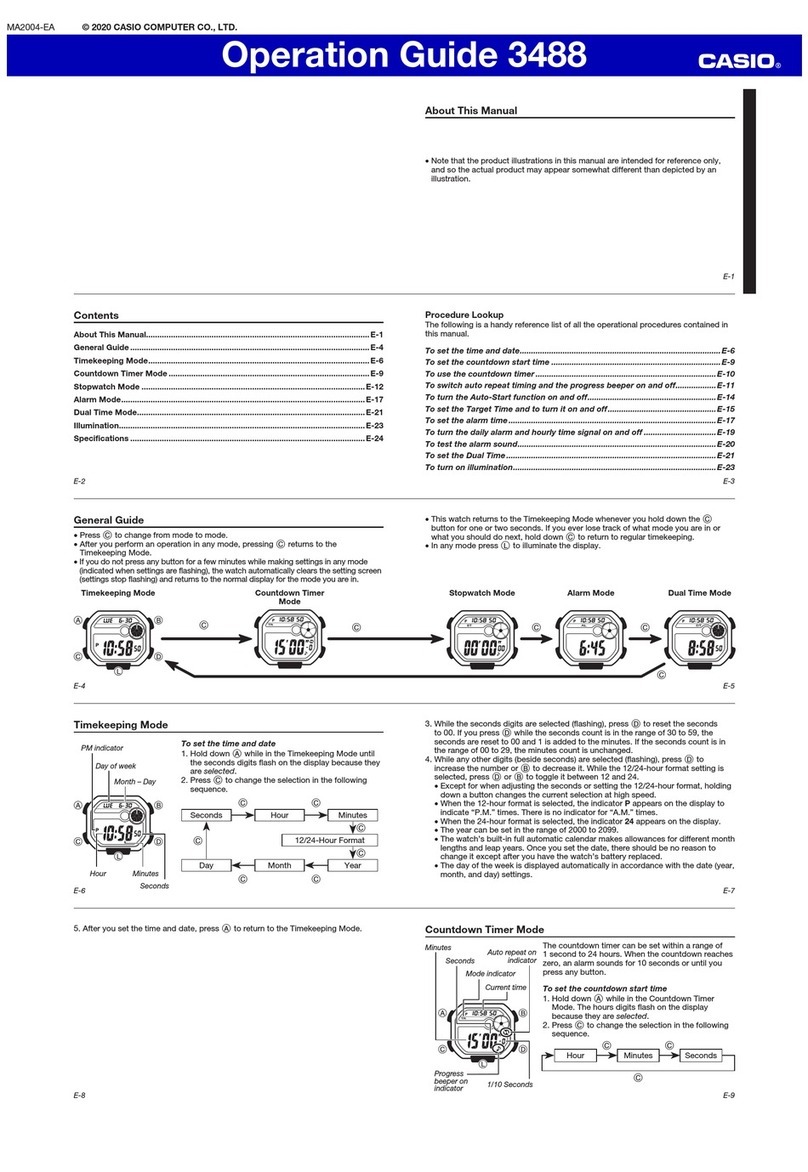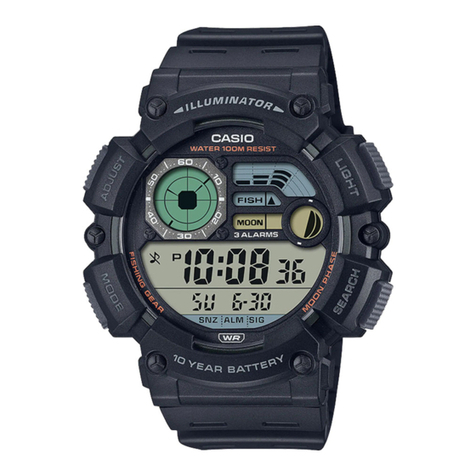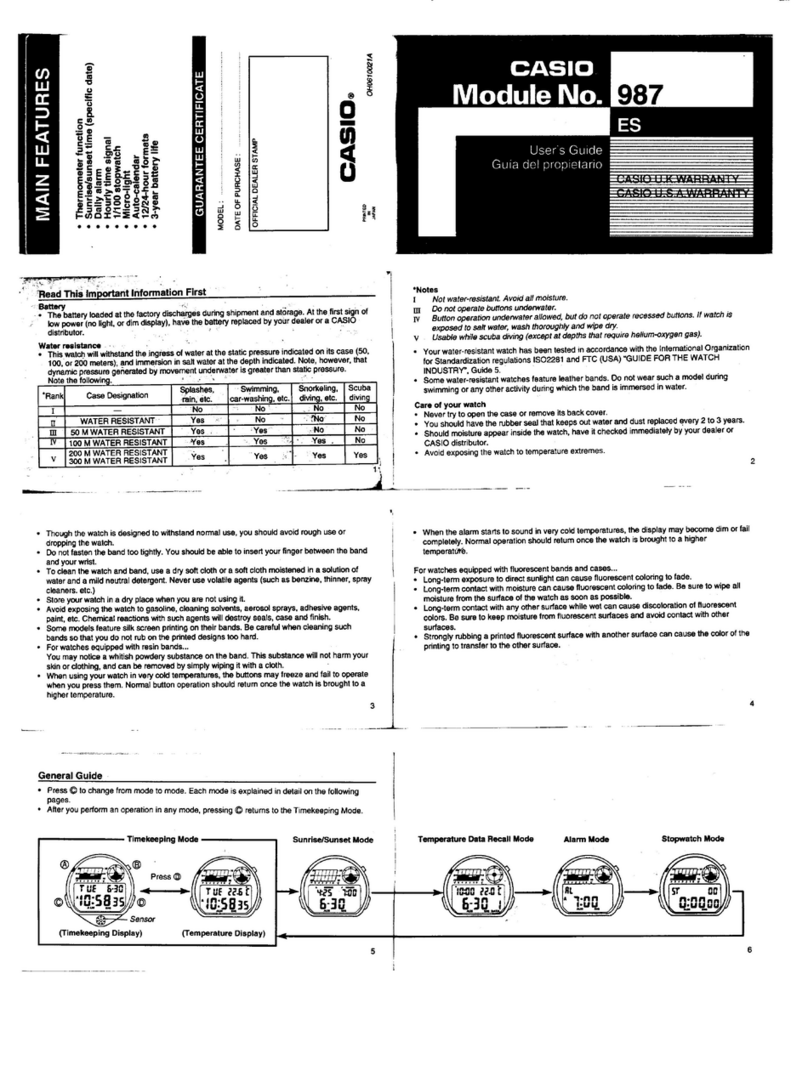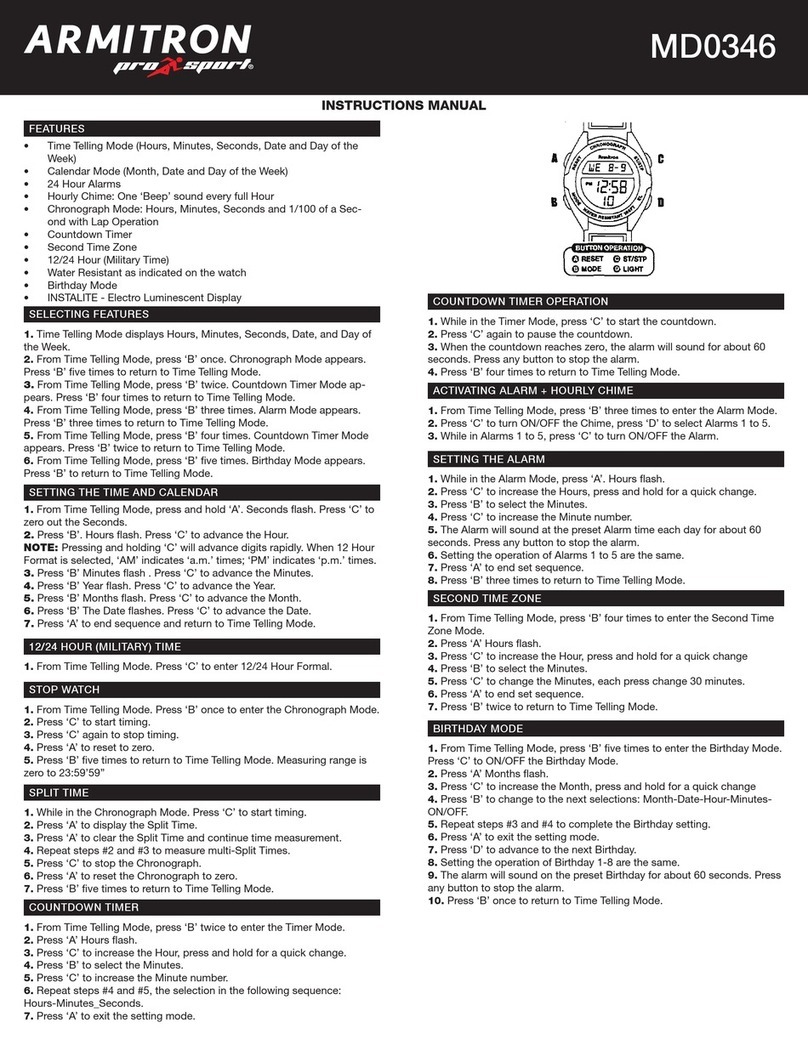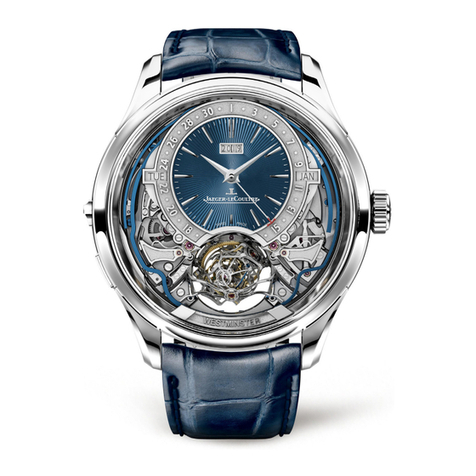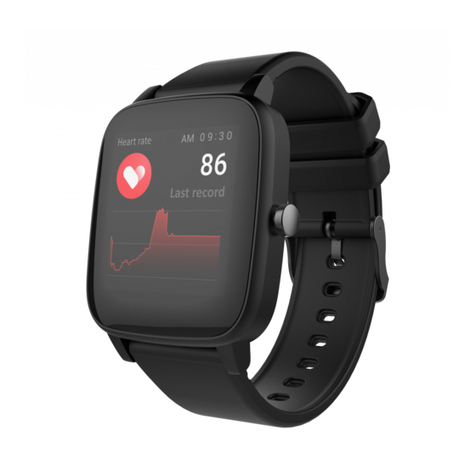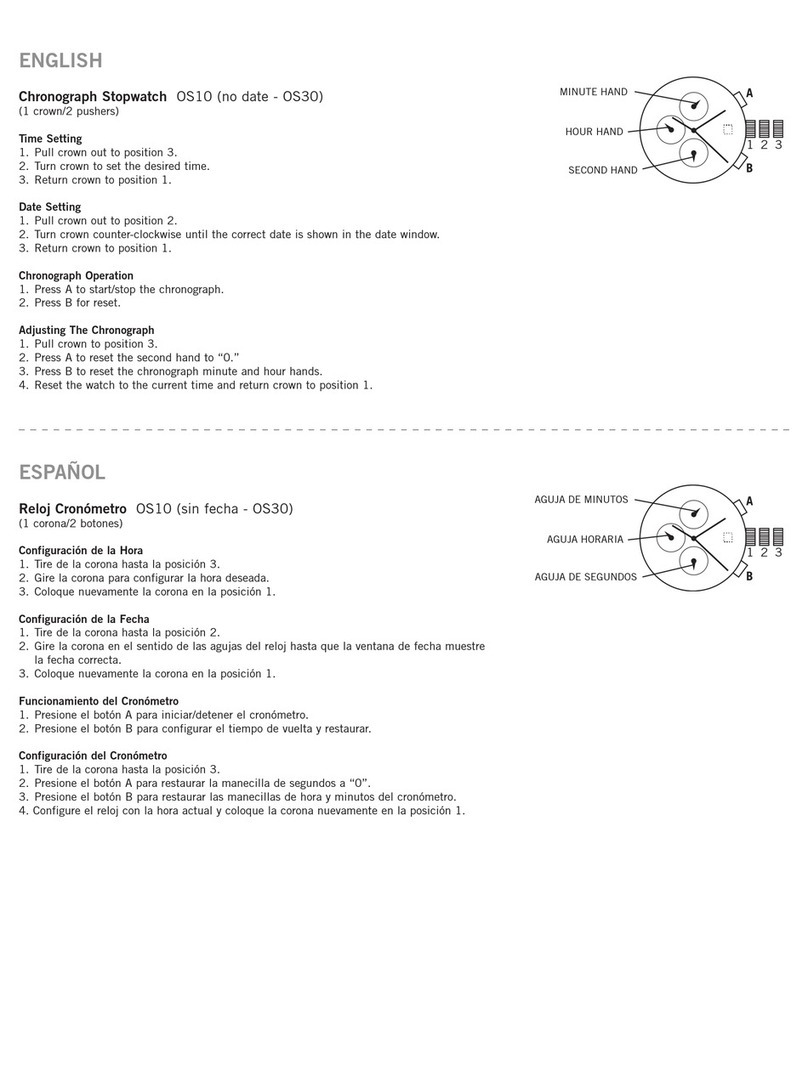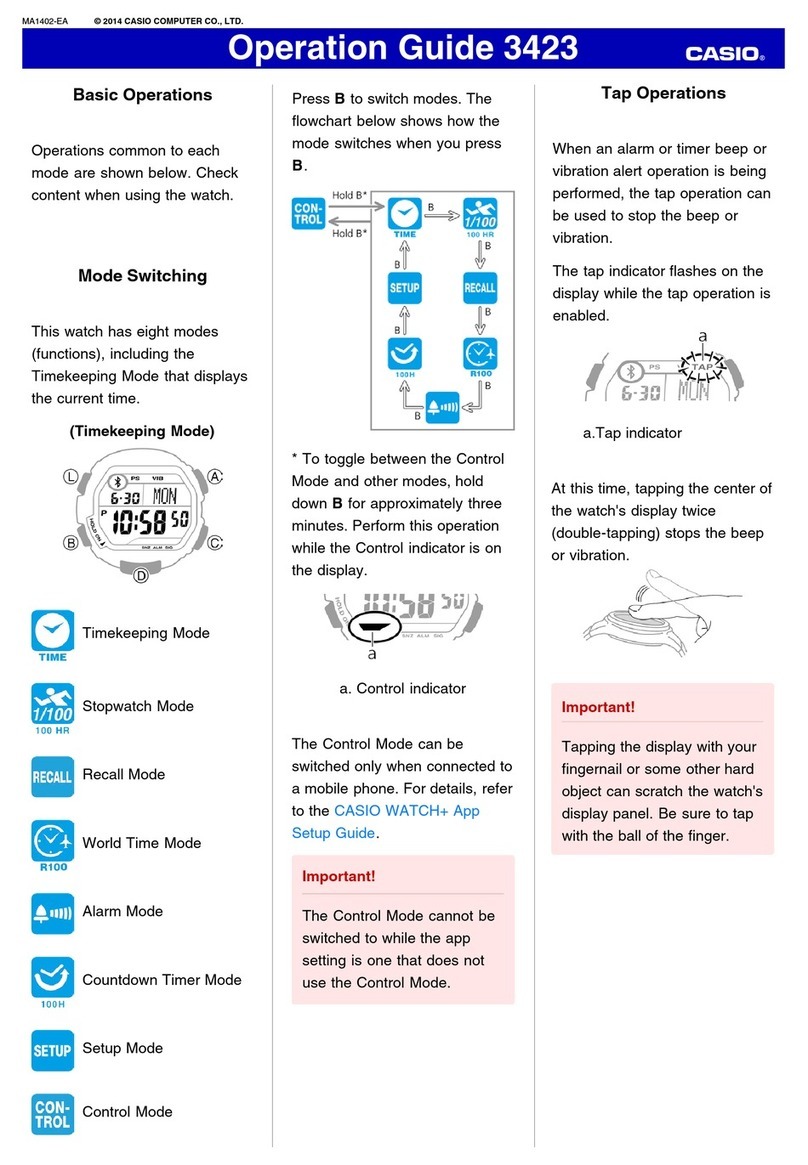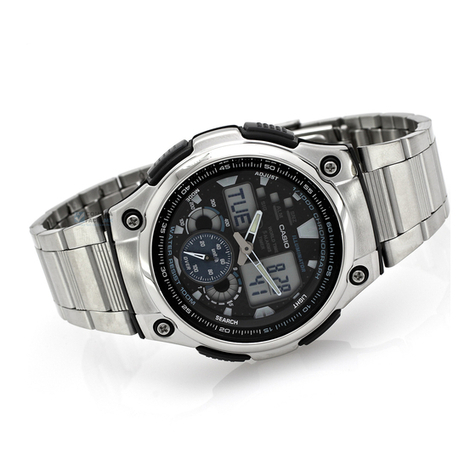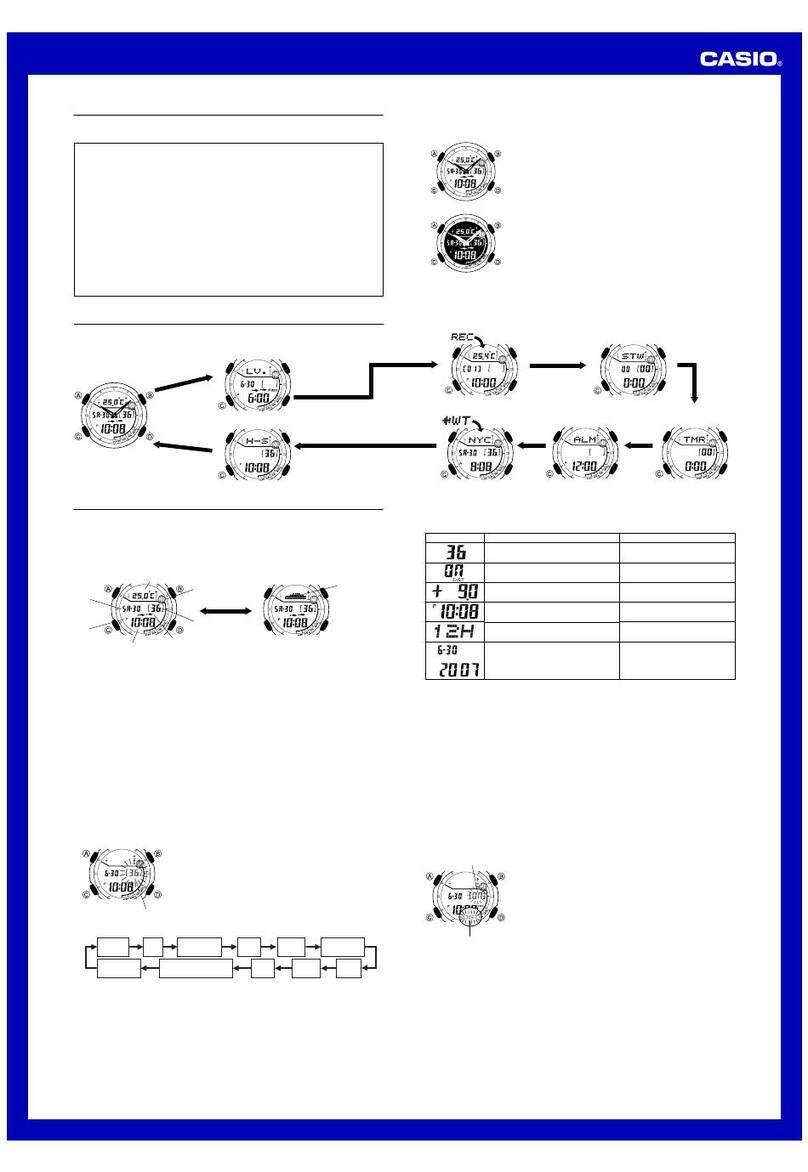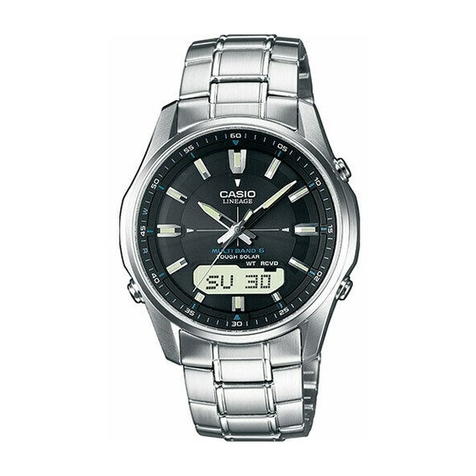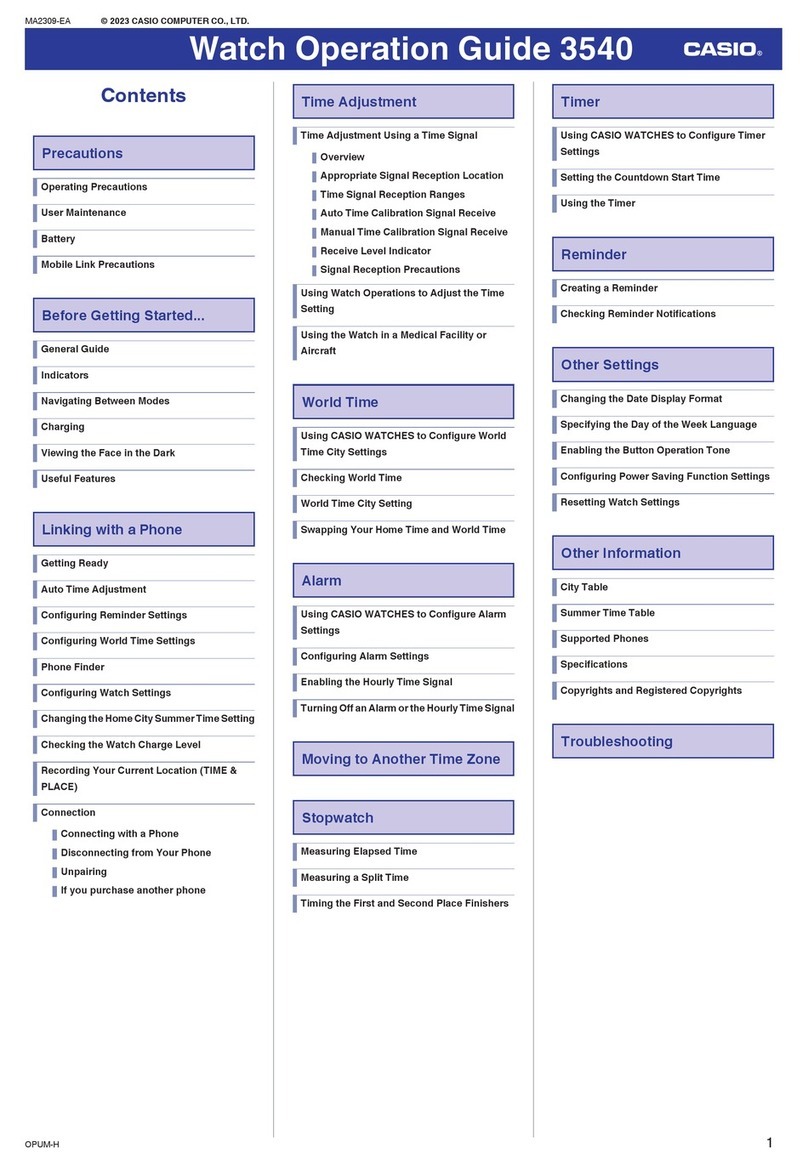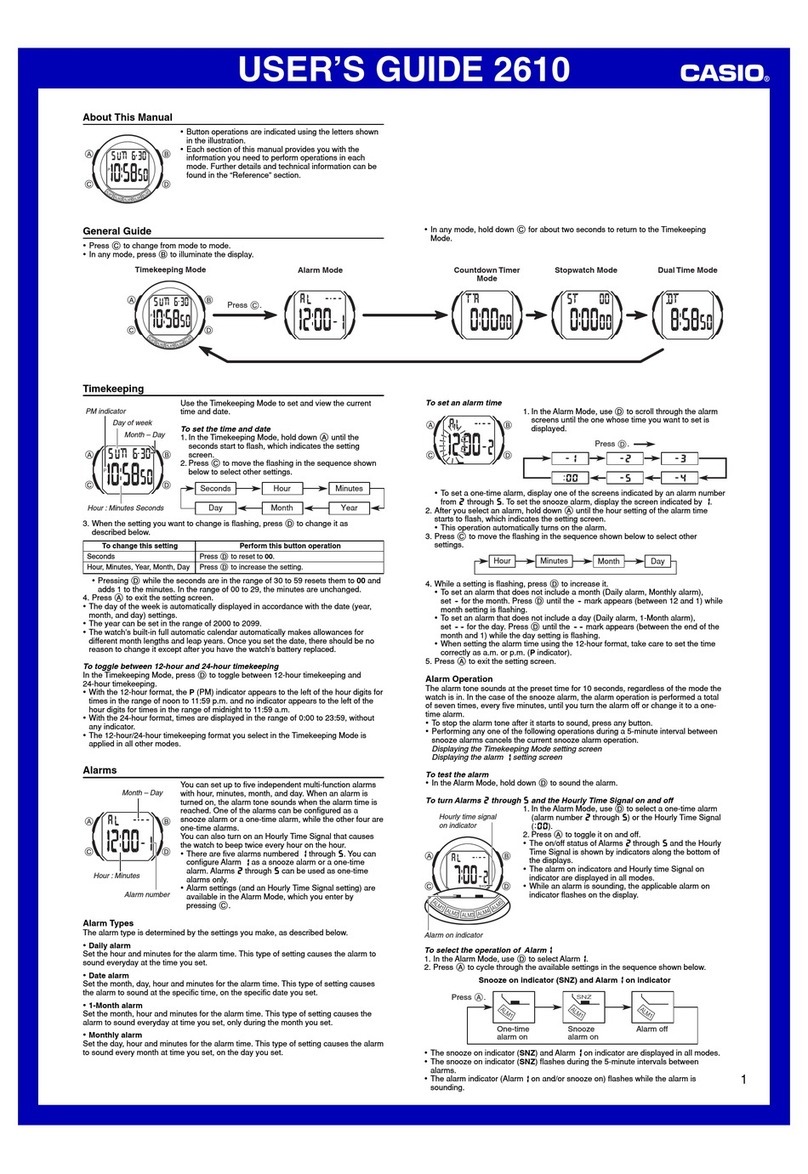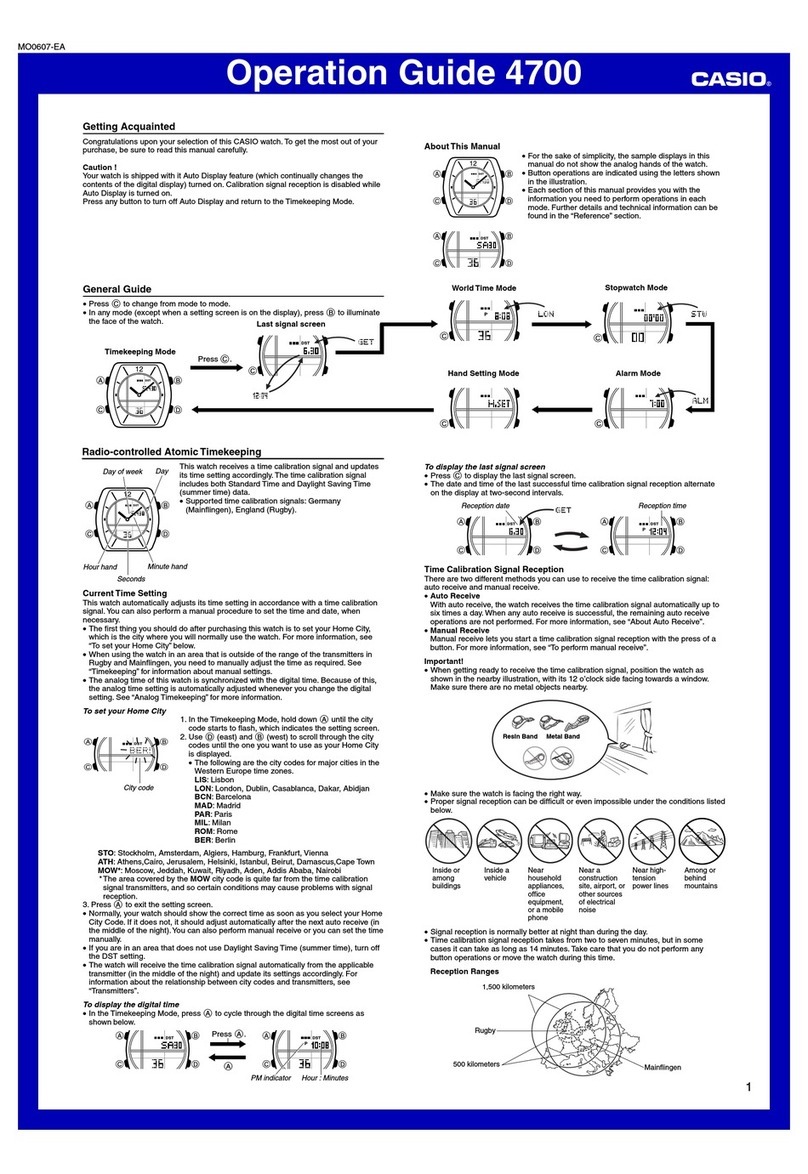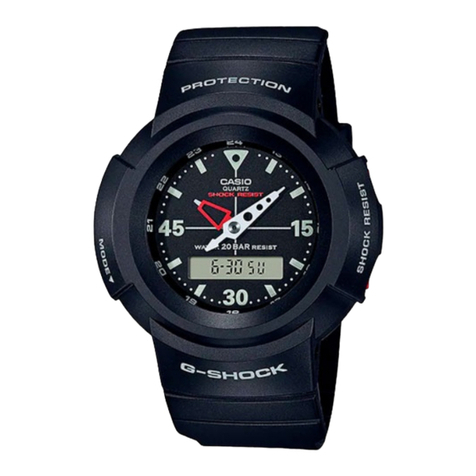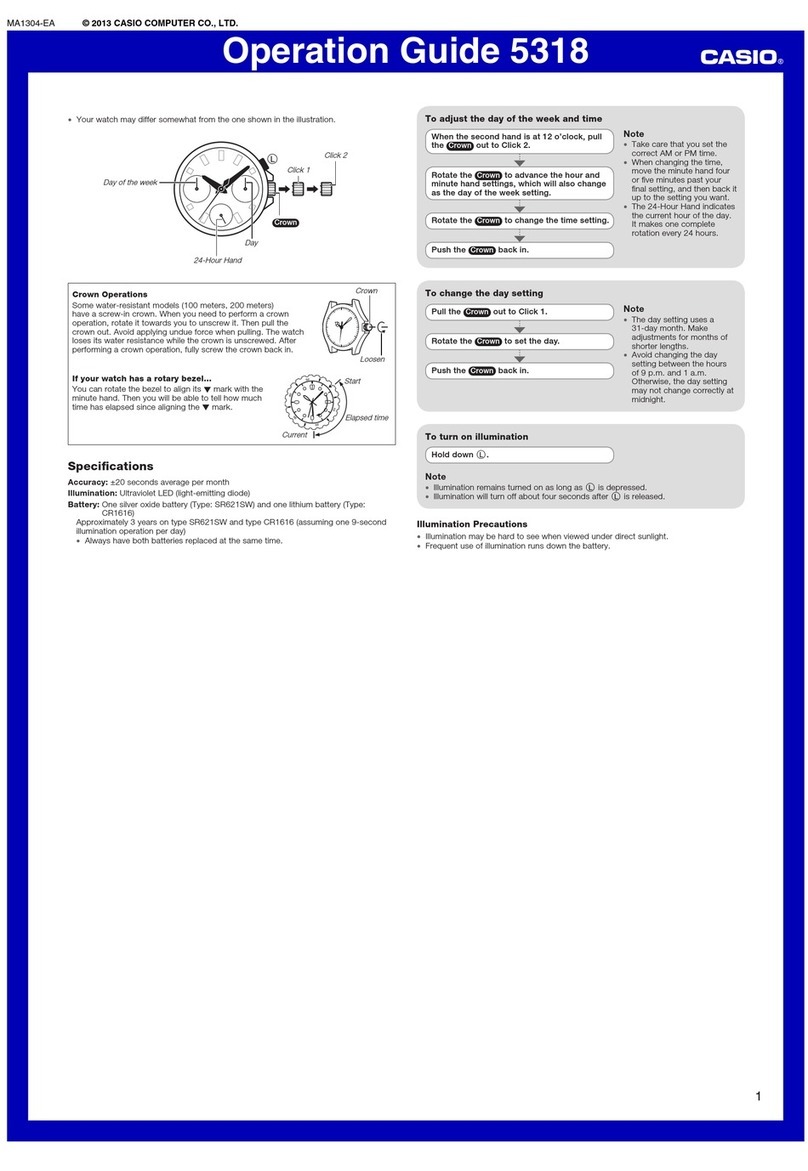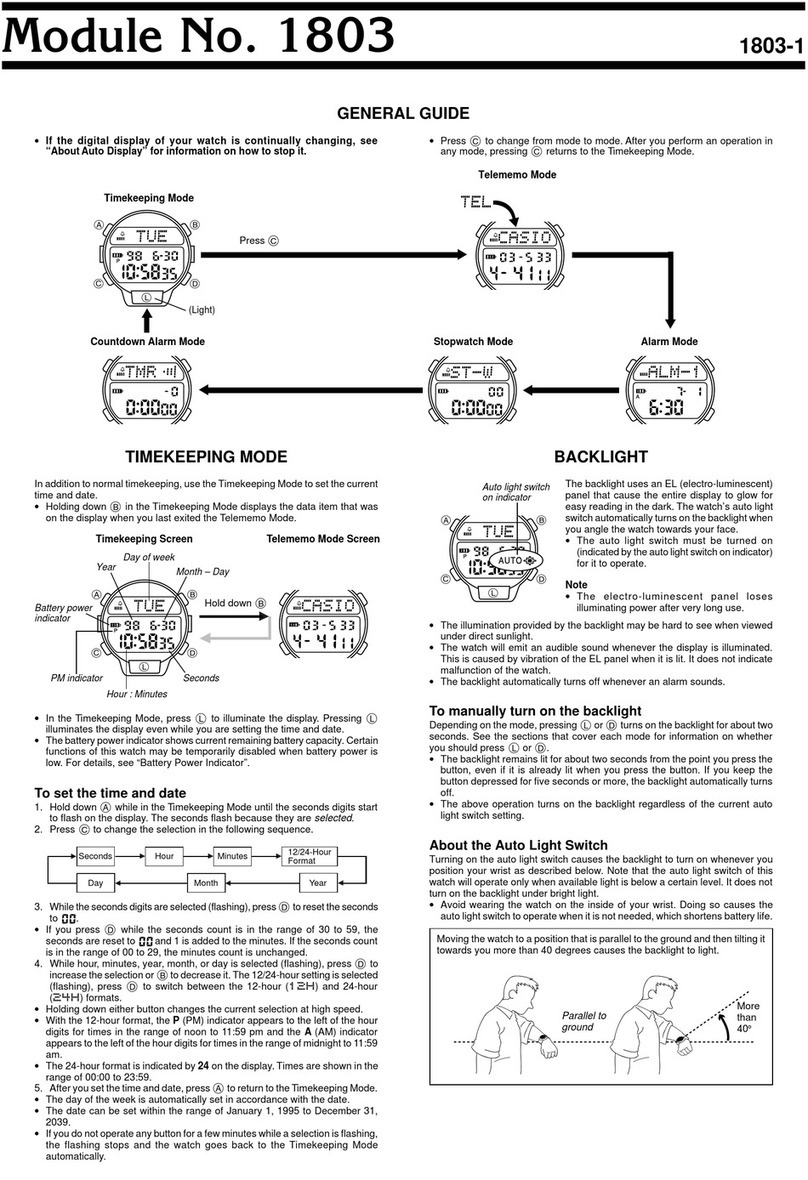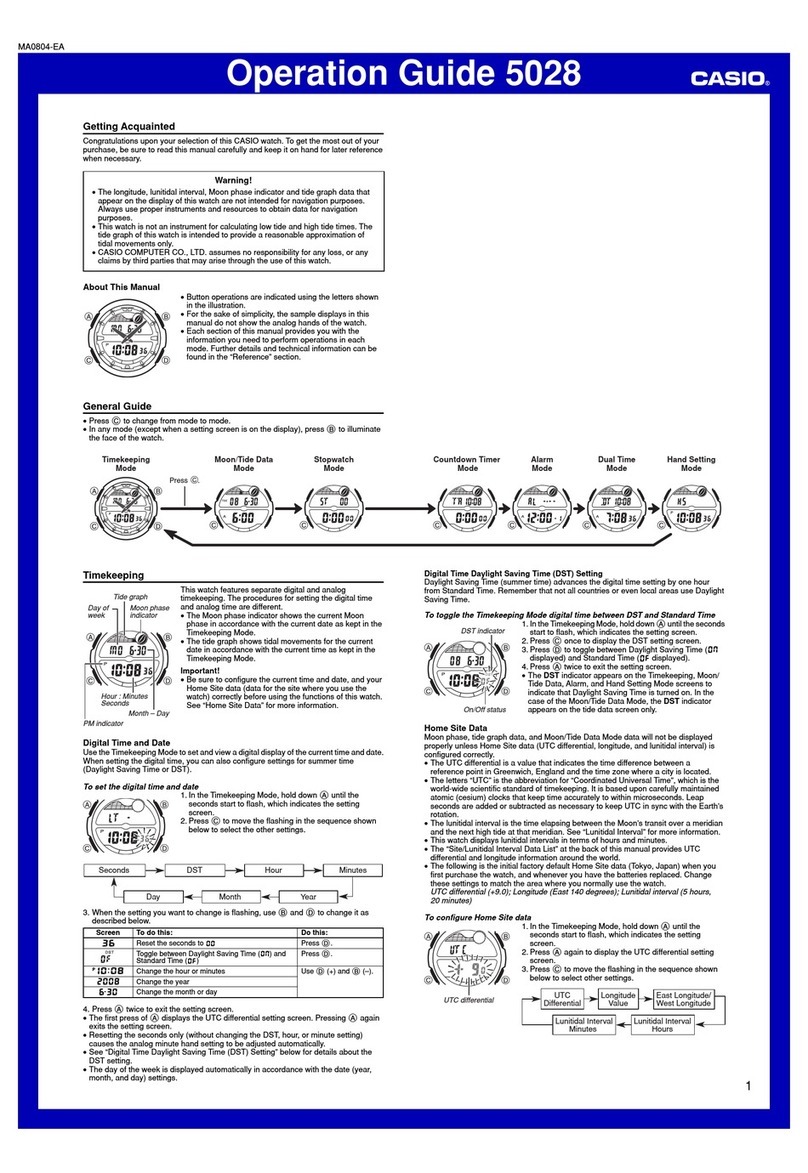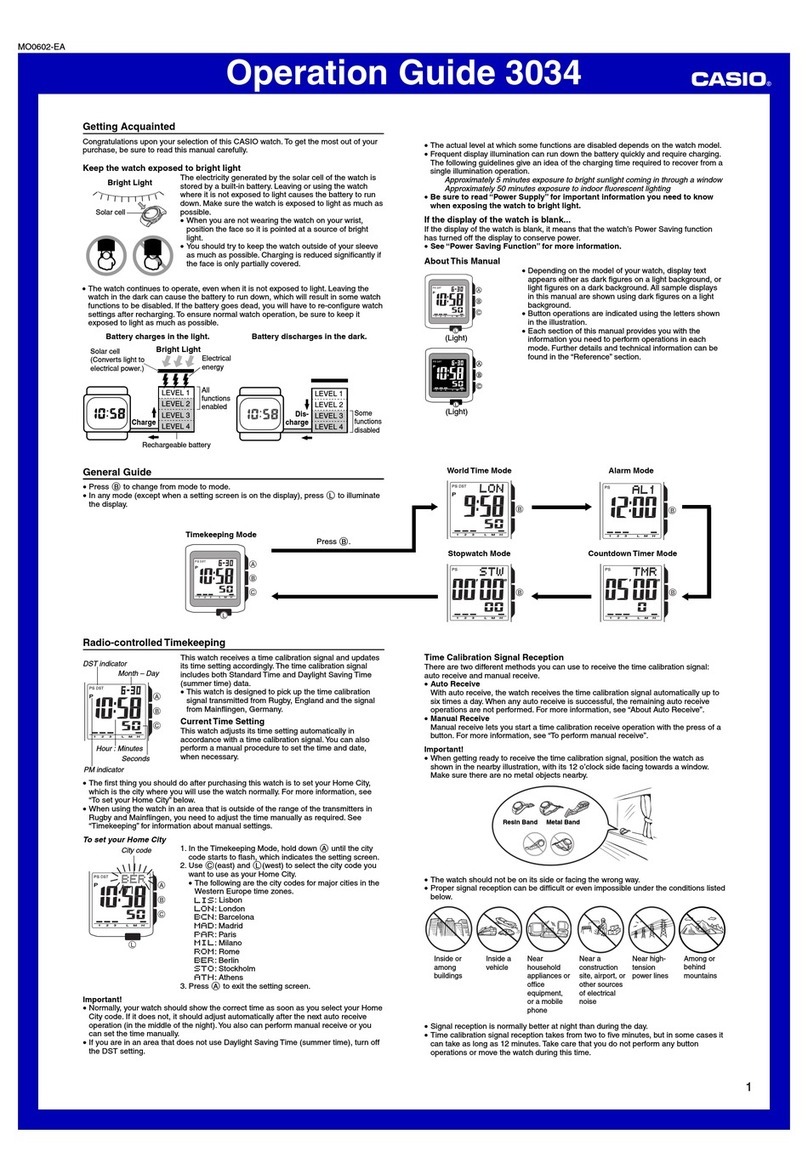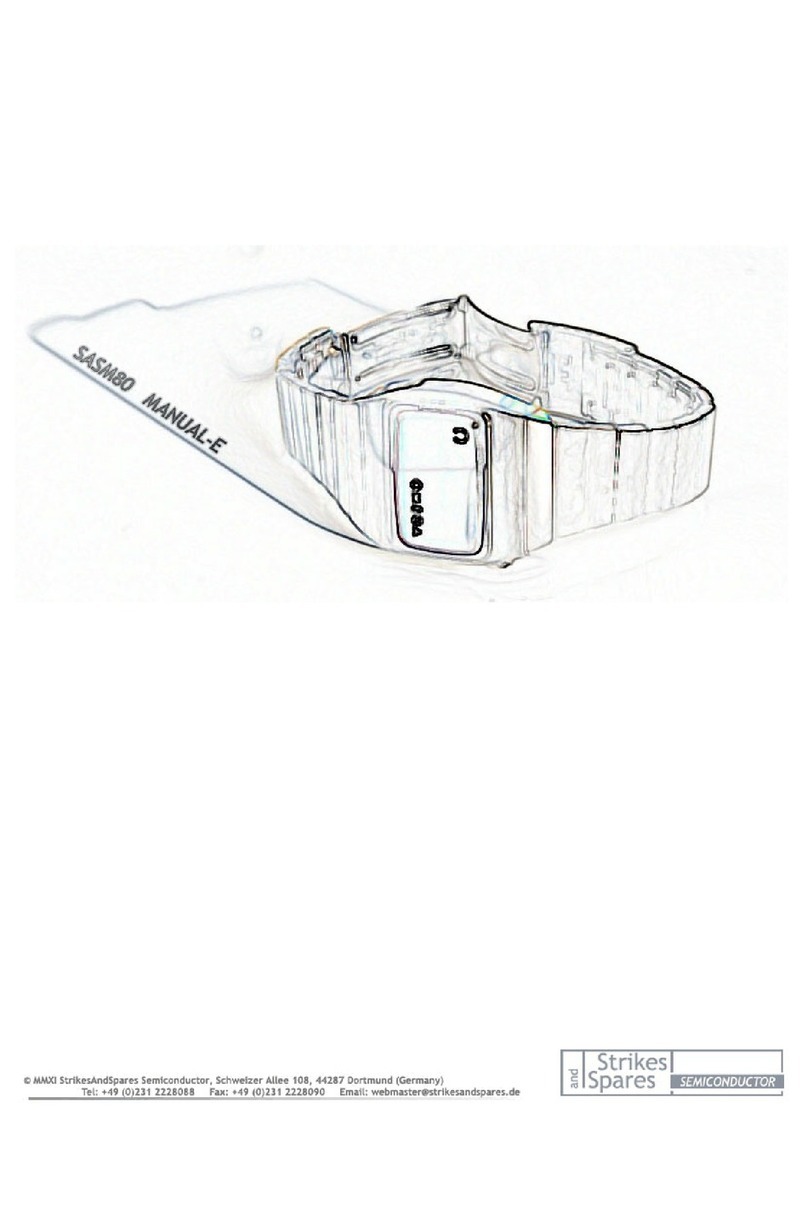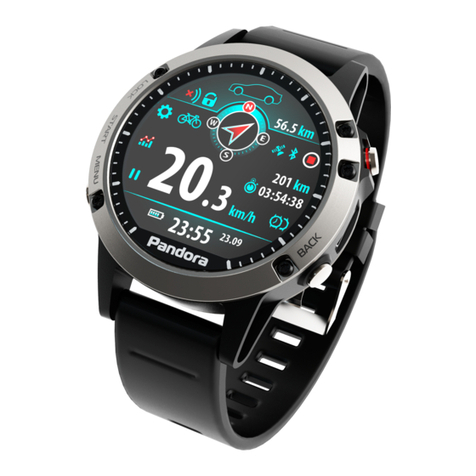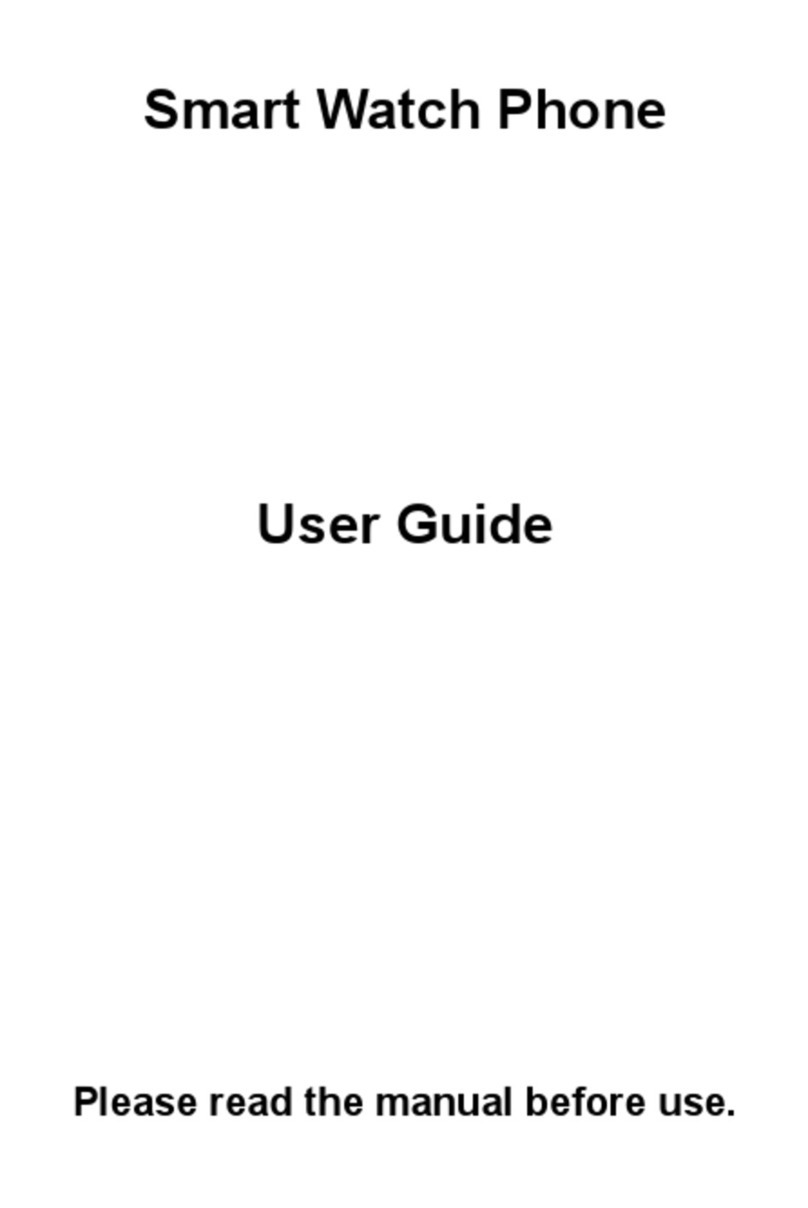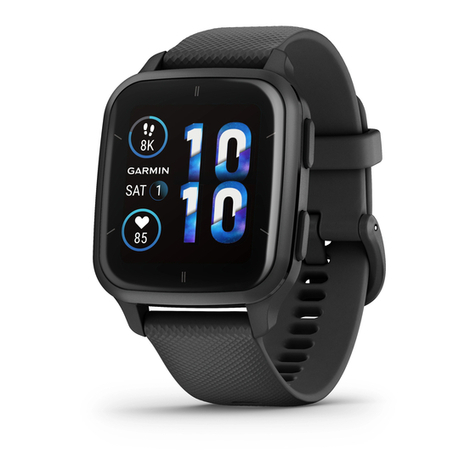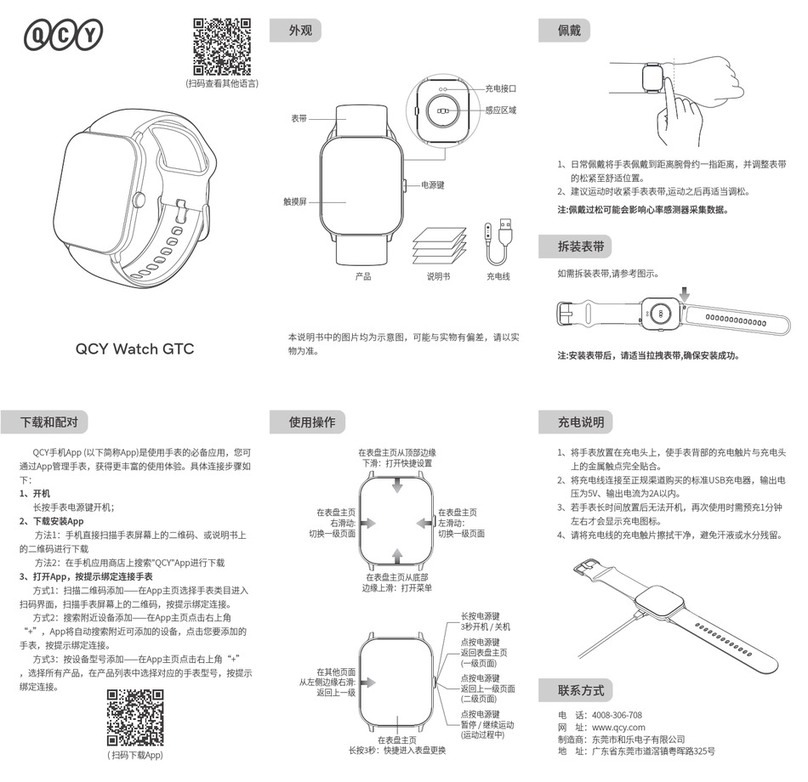
—5 —
Note
•If you are using the time calibration signal to set the time for this watch, be sure to
correctly set your Home City.Otherwise, there is the chance that the watch will not
set the correct time.See “Setting the Time and Date Manually”for details.
•Note that signal reception is possible only when the watch is within range of a time
calibration signal transmitter, and BER, PAR, LON, or ATH is selected as the Home
City code.
•See “City Code Table”for a complete list of available city codes.
•The current time setting in accordance with the time calibration signal takes priority
over any time settings you make.
•Auto receive is turned on when the watch is shipped from the factory.
•See the information under “Time Calibration Signal Reception”if you experience
problems with time calibration signal reception.
To perform manual time calibration signal reception
1.Place the watch on a stable surface so its top (12
o'clock side) is facing towards a window.
•Note that signal reception is poor if the watch is on its
back or side.
2.In the Timekeeping Mode, hold down for about two
seconds until the watch beeps.
•Release and the message RC! appears to indicate
that signal reception has started.
•Time calibration signal reception takes from two to six
minutes.Take care that you do not move the watch
during this time.
•After signal reception is complete, the display of the
watch changes to the Last Signal screen.
•The receiving indicator (Level 4) indicates that the time
calibration reception attempt was successful.
Receiving indicator
Module 2607
Module 2637
Note
•To interrupt a receive operation and return to theTimekeeping Mode, press .
•If the receive operation is unsuccessful, the message ERR appears on the display
for about one or two minutes.After that, the watch returns to the Timekeeping Mode.
•You can also change from the Last Signal or ERR screen to the normal timekeeping
screen by pressing .
About the Receiving Indicator
The receiving indicator shows the strength of the calibration signal being received.For
best reception, be sure to keep the watch in a location where signal strength is strongest.
Weak Strong
[Module 2607]
[Module 2637]
(Level 1) (Level 4)
•Even in an area where signal strength is strong, it takes about 10 seconds for signal
reception to stabilize enough for the receiving indicator to indicate signal strength.
•Use the receiving indicator as a guide for checking signal strength and for finding the
best location for the watch during signal receive operations.
•The receiving indicator (Level 4) remains on the display in all modes following
reception of the time calibration signal and calibration of the watch’s time setting.
The receiving indicator (Level 4) is not displayed if signal reception was
unsuccessful or after manual adjustment of the current time setting.
About Auto Receive
When auto receive is turned on, the watch automatically starts to receive the time
calibration signal when the time in the Timekeeping Mode reaches 2:00 AM, 3:00 AM,
4:00 AM, and 5:00 AM each day (calibration times).
Note
•The auto receive operation is performed only if the watch is in theTimekeeping or
WorldTime Mode when one of the calibration times is reached.
It is not performed if a calibration time is reached while you are making settings
(while settings are flashing on the display) or while an alarm is sounding.
•Auto receipt of the calibration signal is designed to be performed early in the
morning, while you sleep (provided that theTimekeeping Mode time is set correctly).
Before going to bed for the night, remove the watch from your wrist, and put it in a
location where it can easily receive the signal.
•The receiving indicator (Level 4) indicates that either the 2:00 AM, 3:00 AM, 4:00 AM
or 5:00 AM calibration signal reception was successful.Note, however, that the
receiving indicator (Level 4) is cleared from the display at 3:00 AM each day.
•If you do not see the receiving indicator (Level 4) except for the above reason, it
means there was some problem with the calibration reception operation.Either
perform reception manually, or make sure the watch is set up properly to receive the
time calibration signal for the next automatic reception time.
•Though this watch is designed to receive both time data (hour, minutes, seconds)
and date data (year, month, day), certain signal conditions can limit reception to time
data only.
•The receiving indicator (Level 4) is displayed only when the watch is able to
successfully receive both time and date data.It does not appear when only time data
is received.
•Normally, the signal reception date shown by the Last Signal screen is the date data
included in the received time calibration signal.When only time data is received,
however, the Last Signal screen shows date as kept in theTimekeeping Mode at the
time of signal reception.
•When auto receive is turned on, the watch receives the calibration signal for two to
six minutes each day when theTimekeeping Mode time reaches 2:00 AM, 3:00 AM,
4:00 AM, and 5:00 AM. Do not operate any of the watch’s buttons within six minutes
prior to or following the calibration times. Doing so can interfere with correct
calibration.
•Remember that reception of the calibration signal depends on the time kept in the
Timekeeping Mode.The receive operation will be performed whenever the display
shows 2:00 AM, 3:00 AM, 4:00 AM, and 5:00 AM, regardless of whether or not the
Timekeeping Mode time is actually the correct time.
•When two, three, or four receptions are successful, the watch uses the data of the
last reception for calibration.When only one reception is successful, the watch uses
the data of the successful reception.
To turn auto receive on and off
1.In the Timekeeping Mode, hold down Auntil the city
code starts to flash, which indicates the setting screen.
2. Press C twice to move the flashing to the auto receive
on/off setting.
3.Press D
Ato toggle auto receive on (
) and off (
).
4.Press twice to exit the setting screen.
Setting theTime and Date Manually
Make sure you select your Home City code (the city code whose time and date you
are setting) before change the current time and date settings.World Time Mode times
are all displayed in accordance with the Timekeeping Mode settings.Because of this,
World Time Mode times will not be correct if you do not select the proper Home City
code before setting the time and date in theTimekeeping Mode.
Auto
Receive
DSTCity Code
Seconds Hour Minutes
12/24-Hour
Format
Day Month Year
Power Saving
on/off
/ Press A.
Press C.
To set the current time and date manually
1.In the Timekeeping Mode, hold down Auntil the city
code starts to flash, which indicates the setting screen.
2.Press Aor Cto move the flashing in the sequence
shown below to select other settings.
ScreenSetting
City code
DST
Auto Receive
Button Operations
Use (+) and BD
D
D
D
D
(–) to change the
setting.
Press to toggle between Daylight Saving
Time (
ON
) and Standard Time (
OFF
).
•Pressing performs a different
operation when BER, PAR, LON or ATH
is selected as Home City Code.See “Auto
Summer Time (DST) Switching.”
Press to toggle auto receive on and off.
3. When the setting you want to change is flashing, use BDand/or to change it as
described below.
12/24-Hour format
Hour, Minutes
Seconds
Year
Month, Day
Power Saving on/off
Press to toggle between 12-hour (12H)
and 24-hour (24H) timekeeping.
Use (+) and BD
D
D
D
(–) to change the
setting.
Press to reset the seconds to 00.
Use (+) and B(–) to change the
setting.
Press to toggle the Power Saving on
(ON) and off (OFF).
4. Press Ato exit the setting screen.
•The auto receive setting is used for time calibration signal reception only. See “About
Auto Receive”for details.
•See “City Code Table”for a complete list of available city codes.
•Resetting the seconds to 00 while the current count is in the range of 30 to 59
causes the minutes to be increased by 1. In the range of 00 to 29, the seconds are
reset to 00 without changing the minutes.
WorldTime
WorldTime shows the current time in 30 cities (29 time
zones) around the world.
For full information on city codes, see the “City Code
Table.”
The current time for all city codes in the World Time
Mode is calculated in accordance with the Greenwich
Mean Time (GMT) differential for each city, based on the
your Home City time setting.
All of the operations in this section are performed in the
WorldTime Mode, which you enter by pressing C.
Home city time
City code
Current time in the
selected city code
To view the time in another city code
While in the World Time Mode, press to scroll through the city codes (time zones)
to the east or B
D
to scroll to the west.
•If the current time shown for a city is wrong, check yourTimekeeping Mode time and
Home City settings and make the necessary changes.
To toggle a city code time between StandardTime and Daylight SavingTime
1.In the WorldTime Mode, use BDand to display the
city code (time zone) whose Standard Time/Daylight
Saving Time setting you want to change.
2.Hold down Ato toggle Daylight SavingTime (DST
displayed) and StandardTime (DST not displayed).
•The DST indicator is on the display whenever you
display a city code for which Daylight Saving Time is
turned on.
•Note that the DST/Standard Time setting affects only the
currently displayed city code.Other city codes are not
affected.
•Daylight Saving Time (DST) advances the time setting
by one hour from StandardTime. Remember that the
not all countries or even local areas use Daylight Saving
Time.
•The watch will perform a signal receive operation even if
it is in the WorldTime Mode when a calibration time is
reached.If this happens, the WorldTime Mode time
settings will be adjusted in accordance with the Home
City time.
DST indicator
D
D
D
D
ON OFF



